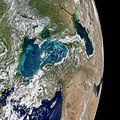Fichier:Turquoise Swirls in the Black Sea.jpg

Gréisst vun dëser Duerstellung: 600 × 600 Pixel. Aner Opléisungen: 240 × 240 Pixel | 480 × 480 Pixel | 768 × 768 Pixel | 1.024 × 1.024 Pixel | 2.048 × 2.048 Pixel | 7.000 × 7.000 Pixel.
Original Fichier (7.000 × 7.000 Pixel, Fichiersgréisst: 16,71 MB, MIME-Typ: image/jpeg)
Versiounen
Klickt op e bestëmmten Zäitpunkt fir déi respektiv Versioun vum Fichier ze kucken.
| Versioun vum | Miniaturbild | Dimensiounen | Benotzer | Bemierkung | |
|---|---|---|---|---|---|
| aktuell | 08:55, 12. Jun. 2017 |  | 7.000 × 7.000 (16,71 MB) | Originalwana | {{Information |Description ={{en|1=Most summers, jewel-toned hues appear in the Black Sea. The turquoise swirls are not the brushstrokes of a painting; they indicate the presence of phytoplankton, which trace the flow of water currents and eddies. O... |
Benotze vu Fichieren
Dës Säite benotzen dëse Fichier:
Globaalt Benotze vum Fichier
Dës aner Wikie benotzen dëse Fichier:
- Benotzt op ar.wikipedia.org
- بوابة:محتوى متميز
- ويكيبيديا:صور مختارة
- ويكيبيديا:صور مختارة/الفضاء والكون
- ويكيبيديا:صور مختارة/الفضاء والكون/نظرة إلى الخلف
- بوابة:محتوى متميز/محتويات
- بوابة:محتوى متميز/محتويات/صور مختارة
- بوابة:محتوى متميز/الرئيسية
- علوم الأرض ناسا
- ويكيبيديا:يوم ويكيبيديا العربية التاسع عشر
- مستخدم:أيوب/يوم ويكيبيديا العربية التاسع عشر
- ويكيبيديا:يوم ويكيبيديا العربية التاسع عشر/تنفيذ الأهداف
- ويكيبيديا:ترشيحات الصور المختارة/البحر الأسود
- ويكيبيديا:صورة اليوم المختارة/أغسطس 2023
- قالب:صورة اليوم المختارة/2023-08-31
- Benotzt op be-tarask.wikipedia.org
- Benotzt op bn.wikibooks.org
- Benotzt op crh.wikipedia.org
- Benotzt op cs.wikipedia.org
- Benotzt op cv.wikipedia.org
- Benotzt op dz.wikipedia.org
- Benotzt op en.wikipedia.org
- Benotzt op fa.wikipedia.org
- Benotzt op fa.wikibooks.org
- Benotzt op frp.wikipedia.org
- Benotzt op fr.wikipedia.org
- Benotzt op gl.wikipedia.org
- Benotzt op he.wikipedia.org
- Benotzt op hu.wikipedia.org
- Benotzt op hy.wikipedia.org
- Benotzt op hy.wikibooks.org
- Benotzt op it.wiktionary.org
- Benotzt op ka.wikipedia.org
- Benotzt op ko.wikipedia.org
- Benotzt op lbe.wikipedia.org
- Benotzt op lez.wikipedia.org
Kuckt globale Gebrauch vun dësem Fichier.




